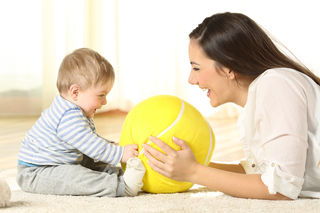Social Learning Theory
Babies Learn When in Sync with Their Mothers
New research shows that interpersonal connection boosts social learning.
Posted April 25, 2019

Ever tried to convince a baby to try a new food like broccoli? You probably ate some yourself and made yummy noises. The lesson you hoped the baby picked up—from your example rather than direct experience—was that broccoli is delicious. Some children just don’t seem to learn, however, and others, much to their parents’ frustration, often do the opposite of what was suggested. Now, for the first time, neuroscientists have looked at what’s going on inside the brains of both babies and mothers as they engage in this kind of social learning. The findings show that how well a baby’s neural activity syncs with its mother's predicts some aspects of social learning. The research also provides an explanation for why some babies are so darn contrary.
Neuroscientist Victoria Leong and her colleagues at the University of Cambridge used a technique called hyperscanning to watch two brains—mother and baby—at once. Hyperscanning can be done with a range of neuroimaging technology, but this study used EEG (electroencephalography). The results were reported at a symposium on "the emerging neuroscience of social connectedness" at the annual meeting of the Cognitive Neuroscience Society last month in San Francisco and are currently under review for publication.
With her baby sitting in a high chair, each mother was instructed to hold up one toy, smile and say something like, “Oh, I like this. Let’s play with this one.” For the second toy, she was instructed to frown and say, “This is bad. I don’t want to play with this one.” Then the toys were put in front of the baby and the researchers tracked which toy each baby grabbed.
Social learning is powerful and important, but it is complex to study in part because it involves two people. “There’s the information being transmitted, but also who is talking and who is listening and whether the person listening decides that they will believe you,” says Leong, who also has a lab at Nanyang Technological University in Singapore. Although this form of learning has been studied behaviorally for decades, neuroscientists have shied away from it, Leong says.
In her new study, if the baby picked one emotionally labeled toy over the other more often than chance would predict, she considered that learning. The likelihood that learning took place could be predicted by the level of synchrony between the pair’s brainwaves. The more in sync the mother and baby were, the more likely the baby was to learn.
But the results were a little more complicated, and a little more interesting, than that. One-quarter of the babies consistently chose the negatively modeled toy. They were learning what their mothers preferred, but their response was to choose the other toy. The researchers called this phenomenon “learning valence,” to reflect the direction of the child’s emotional choices. Did the baby tend to follow mom’s lead or not?
In their analysis, Leong and her team separated these two measurements: learning likelihood and learning valence. What they found surprised them. “There was an almost perfect dissociation in the brain patterns that predict emotional valence as compared to whether or not the child’s actually going to learn on this trial or not, which is learning likelihood,” Leong says. “It was so strong we were shocked.”
The only thing that predicted learning likelihood was how in sync the brain patterns of mother and baby were, what Leong calls “the interpersonal connection between the mum and the baby.” The study measured alpha waves. One of several bands of brainwaves, alpha waves were chosen for the strength of their signal. Brain synchrony means that those alpha waves rise and fall in a predictable pattern, or that the peaks and troughs of each person’s oscillations consistently track that of their partner. Such synchrony has been seen in audience members watching the same concert or students who are highly engaged in a biology class. Leong speculates that receptivity to learning might be higher at certain points in oscillation and that learning improves when the cycles of brain waves are synchronized.
Whether or not the baby then took mom’s advice depended entirely on the baby’s own internal brain activity, not the connection between baby and mother. Intrigued, the researchers looked further into what predicted learning valence with a set of psychological measurements of the temperament of both mother and baby. The similarity in temperament was a strong predictor.
The finding makes senses, Leong says. “You’re a very introverted, quite quiet and shy baby who doesn’t like a lot of extra stimulation. And you’ve got this super extroverted outgoing mum who loves things that are really intense. Maybe over time, this child has learned that what my mum likes, I actually don’t really like. That might explain why if the babies had a very different temperament from their mum’s, they tended to go for the opposite object.”
If that kind of difference describes you and your baby, do not despair. On both fronts, learning likelihood and learning valence, there was encouraging news. Mothers who were more sensitive to their baby’s responses, using more eye contact and infant-directed language (the higher-pitched, sing-song cadences we naturally use with infants) were more in sync with their babies than moms who were less responsive. Those are skills that can be taught and practiced. (In a previous paper, Leong showed the power of eye contact.)
It is early days as this kind of work is so new, but Leong hopes it could have real benefit for mothers who suffer from post-partum depression or other conditions where interaction between babies and parents needs strengthening.
The work is also a sign of how nuanced social learning really is and how important it will be to study it with hyperscanning. “That’s the brain activity confirming that there are two different kinds of learning processes and they’re indexed by different neural circuits,” Leong says. “If we had only measured the brain activity of the child, we would be able to see the learning valance, but we would never have been able to see the moment-by-moment changes that predict whether the child is going to learn because all of that was happening in the interpersonal space.”
Copyright: Lydia Denworth, 2019
If you enjoyed these posts, sign up here to have them delivered to your inbox.




